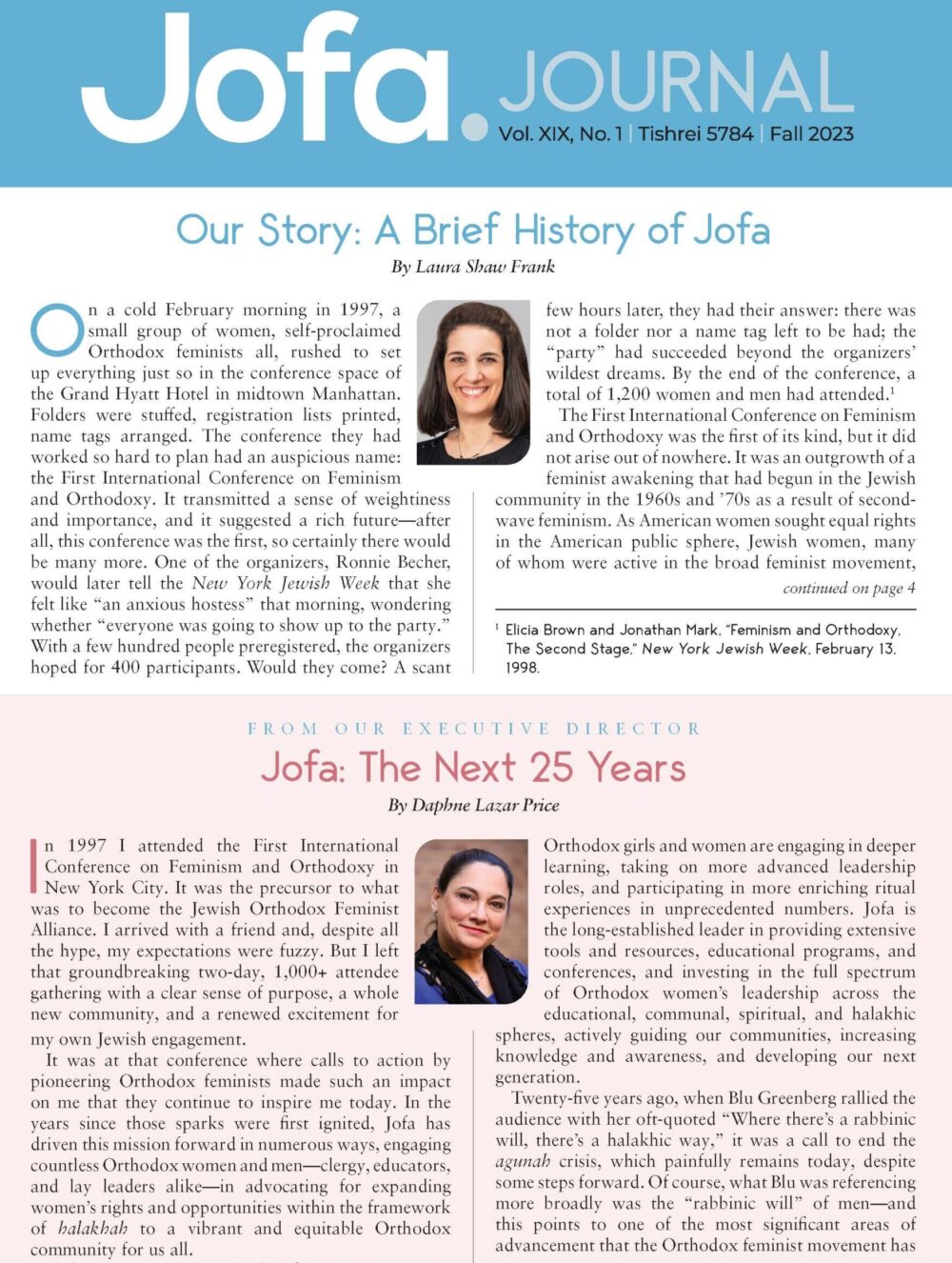By Ruth Halperin-Kaddari
This article comes from a place of frustration and pain. I am afraid I do not bring a message of optimism. On the contrary, my article stems from a deep sense of pessimism. Not total hopelessness – not yet, at least – but despair and distress. My aim is to analyze what I see as our failure in the area of Jewish divorce law, and put this in a larger context.
For some years now I kept asking myself, and was constantly being asked, where do we stand in this, is there any progress, am I optimistic or pessimistic? It is very dangerous for a scholar and an activist committed to a cause, to conclude that her work, as well as the work of others who share the cause, is failing. It is therefore understandable why I personally have tried to avoid this conclusion. But lately, as I have engaged in work in broader areas of general family law both in Israel and other countries, and particularly in an empirical research study of divorce professionals in Israel, I realized that my “un- admitted” sense of failure is neither groundless nor isolated. In fact, it is part of a much broader problem of lack of progress, regression, and even backlash with respect to women’s position and women’s rights in divorce in general. Furthermore, this backlash both results in and reflects an even deeper phenomenon of gender differences in perceptions of equality in justice in cases of divorce in general.
Realizing this has made it easier for me to admit our predicament and face it openly. A crucial stage in devising the means to honestly face any situation is to understand its source. In this case, I believe that it is important to view our very specific subject-matter of agunot and mesuravot get (women who are refused a get) in the broader context of gender, power and divorce.
I will start by surveying the current situation with respect to the position of women in halakhic divorce, primarily in Israel, and will focus on those issues which I take as causing the lack of progress and actual regression. I divide these issues into two categories based upon the nature of the halakhic-social process that they reflect. The developments in this painful area of agunot and mesuravot get serve as a fascinating illustration of two opposing socio-halakhic processes: a “top-down” development, as opposed to a “bottom-up” progression. While these courses of action are common within the halakhic process, their simultaneous interaction in the divorce area is particularly interesting, and its analysis can be quite illuminating. In this brief overview, I offer a modest beginning for this analysis. I will then describe expressions of a backlash phenomenon in the Israeli family courts and even the High Court of Justice, and will address some of the findings of research conducted among divorce professionals in Israel relating to perceptions of gender power differences in divorce. After that, I will discuss, very briefly, a couple of issues in family and divorce law in the West, which demonstrate the same phenomenon. Finally, I will raise some thoughts about the conclusions that can be drawn from this analysis, and about the importance of judicial education.
Current State of Affairs regarding Women and Jewish Divorce in Israel
“Top-Down” Process I: Annulment of Marriage – קידושין הפקעת
There has now been over a century of attempts to solve the “modern-day agunah” problem. Ever since civil marriages were introduced in France in 1884, Jewish couples began divorcing and remarrying civilly while neglecting to divorce halakhically. This led to severe problems of mamzerut. More to our point, Jewish men discovered their superior power over their wives with respect to the get, which they–the men–no longer needed as much as their wives still did. The men now had the option of civilly remarrying with no halakhic repercussions, knowing that their wives would suffer severe halakhic repercussions if they did the same. Thus, the ugly scheme of extortion and abuse of the power to withhold the get started. Rabbinical authorities did not stand idle. They may have been more worried about the spread of the mamzerut problem than the agunah problem. There were numerous attempts to solve both these problems, which stemmed from the same source: the control that the husband has over the giving of the get. All the solutions offered were directed at circumventing the husband’s control, by enabling the termination of the marriage without the need of the man’s issuing the get, whether through introduction of conditions into the marriage (תנאי על קידושין) – as in the initial attempt of the French rabbis at the end of the 19th century or by authorizing the beit-din, upon the dissolution of the marriage, to grant a get when the need arose as suggested by Rabbi Henkin in 1925. All the proposed solutions had something else in common: they all failed. Thus, for instance, the French rabbis were threatened with a boycott of their marriages and divorces and a critical pamphlet בנישואין תנאי אין was published. Similarly, an attempt to reintroduce the annulment of marriage in the first part of the 20th century by Rabbi Toledano, then the chief Rabbi in Palestine, was met with much resistance.
The point of this short account is that השמש תחת חדש אין, nothing is new under the sun. Isolated cases of recalcitrant husbands are not new phenomena, and the responsa literature is filled with various solutions and attempted solutions. Likewise, the spread of the extortion phenomenon is not new, and organized overall solutions were always attempted. But the dynamic remains the same: total rejection of any such attempts.
The latest attempt of last year in Israel was a revival of the old suggestion to reintroduce the concept of קידושין הפקעת(annulment of marriage), this time on the initiative of Rabbi Riskin, who published an article arguing for the halakhic legitimacy and urgency of this method in תחומין, the leading semi-academic halakhic journal in Hebrew. Rabbi Riskin’s call was embraced by Kolech, which organized – through one of its members, Zehava Fisher – a campaign to promote the idea, and succeeded in recruiting Prof. Berachyahu Lifschitz, an expert on Jewish Law of the Hebrew University to draft proposed legislation converting the halakhic concept into civil terms through adoption of the nullification of the worth of the betrothal ring and therefore the annulment of the marriage in specific cases. However, the subsequent issue of תחומין already contained a harsh critique of Rabbi Riskin’s article. Even more alarming was the fact that when we tried to organize a symposium to discuss this initiative, our calls to leading rabbis of mainstream Israel Orthodoxy to participate in the event were all met with either polite refusals or impolite evasions. I was reminded of an identical experience I had nearly five years ago, when,
together with Rabbi Dr. Noam Zohar, we organized the first–and only–academic conference to discuss the previous methodological attempt to solve the agunah problem, the Rabbi Rackman’s beit-din method of bitul kiddushin, – the voiding of marriage on the ground of error. Then too, no leading central figure of the mainstream rabbinical world agreed to participate. This, in my view, is the ultimate reflection of the tragic state of affairs: there is no willingness, or courage, to even discuss the proposals. In complete reversal of the essence of the halakhic process, namely the daring consideration and investigation of bold propositions, the rabbinical establishment at present bars any attempt to think–not to mention act –outside the conventional halakhic box, when the terms ‘conventional’ or ‘conservative’ are defined in the narrowest possible terms.
Needless to say, so far the Orthodox rabbinical establishment has accepted neither of these attempts. Consequently, the proposed legislation on Rabbi Riskin’s proposal, introduced by MK Orit Noked (of the Labor-Meimad party), has recently been voted down.
“Top-Down” Process II: Lack of Use of “The Sanctions Law”
An apt illustration of the disappointing dynamic, characteristic of the “top-down” process, is the legislative measure that was introduced a decade ago which promised to eliminate all cases of recalcitrant husbands: in my view, this has proven to be far from effective, and is only rarely used. The Rabbinical Courts (Enforcement of Divorce Decrees) Law – 1995, popularly known as the “Sanctions Law”, permits rabbinical courts to issue various restraining orders against recalcitrant husbands. The form of these sanctions is suspension of one or more of civil rights and benefits, including the right to leave the country; to hold a driving license; to hold a passport; to hold a bank account; to practice as a professional where a license is needed; to be nominated to public office; and to be eligible for parole in case the husband is a convict. The harshest form of restraining order available through this law is the incarceration of the recalcitrant husband for a specified period of time. Nonetheless, ever since this law was passed, the number of restraining orders issued annually remains only around forty, and the data clearly shows the predominance of one particular rabbinical court that consistently issues almost half of the sanctions, while some other courts hardly issue any such orders. Furthermore, on the practical level, fewer than half the cases where restraining orders are issued actually result in a divorce. While the Rabbinical Courts’ Administrator, as well as some dayanim, usually claim that in many cases there is no need to utilize the actual sanctions, since the mere threat of using them is enough to propel the husbands to grant the get, the numbers are still disappointingly low and cast a grave doubt over the effective usage of this important tool.
“Top-Down” Backlash: Growing use of “unconventional weapons” – the Retroactive Invalidation of the Get
The most alarming development coming from the established rabbinical courts in Israel is the growing use of the retroactive invalidation of a get, after it has been issued. This step comes after the practice of conditioning the get upon various concessions from the woman – which usually evolve around rights previously accorded to her by the secular legal system. It has become accepted by many rabbinic courts, which actually cooperate
in this, basing themselves upon a problematic ruling of the Maharashdam (16th century). The actual invalidation of the get after it has been issued represents an escalation of the means used by the rabbinic courts, upon the request of the husbands, to draw concessions from their wives. Most of the time, this also represents the escalation of the struggle over jurisdiction between the rabbinic and the civil courts. Indeed, this practice often takes place as part of the more general jurisdictional struggle between the rabbinical courts and the civil family courts in Israel. A classic case is one in which the wife has managed to have matters of property, child custody and support adjudicated in secular family court, and is being requested by the husband to transfer these matters to the rabbinical court as a condition for granting her the get. Sadly, many rabbinical courts accept this demand as a legitimate pretext for withholding the get. The more outrageous case is where the get has been issued, based upon a certain agreement, and the woman brings a new child-support action, in the name of the children in the family court, as she (and they) is entitled to do under Israeli law. The man then turns to the rabbinical court requesting the invalidation of the get, claiming that he would not have agreed to give the get had he known that he would be subject to further proceedings in the family court.
“Bottom-Up” Process I: Pre-nuptial agreements
While I personally have put a lot of efforts in the task of advancing the adoption of pre- nuptial agreements in Israel, I am fully aware that this is not a total solution, only a preventive method, and even then it is far from being fully “extortion-proof”. We have to admit openly that there is no guarantee that this method will indeed work. It is quite possible that some dayanim will continue to reject the method used by the pre-nuptial agreement as a means of inducing the get. Moreover, there is no way to overcome the risk that a husband who is party to such an agreement will nonetheless claim he has been wrongfully coerced into giving the get for fear of having to pay according to his signed pre-nuptial agreement.
Having made this reservation, I nonetheless believe in the importance of advancing this concept, for a combination of reasons, ranging from the educational value of the enterprise to its actual potential of prevention of extortion. Even such a modest initiative has been met with almost wall-to-wall objection. The תחומין journal has played an important role here too. Two of its issues set the stage for a heated halakhic debate on the validity of a get issued on the basis of enforcing such a pre-nuptial agreement. Most of the debate had centered round a version of the pre-nuptial entitled “Agreement for Mutual Respect,” produced by a working group of four women and four men who have met for more than three years in an effort to reach the “ultimate pre-nuptial”, which will be valid and enforceable both halakhically and legally. This working group, consisting of rabbis, lawyers, rabbinic advocates, academics, ardent feminists as well as non-feminists, is perhaps the best illustration of the stimulating and inspiring grass-root process that has taken place in the past few years.
This, I believe, cannot be overemphasized. While the advancement with respect to this particular initiative is indeed frustratingly slow, the important point is that this takes place at “ground-level,” and not through the establishment. In sociological terms the process here is from the bottom-up, not the other way round. And this is perhaps its added value,
and why I still believe in its significance and potential. It represents the only development, at present, in this area of divorce laws that captures the possibility of “bottom-up” operation within the halakhic process.
“Bottom-Up” Process II: International Coalition For Agunah Rights and other Developments
While this is not a description of a specific halakhic development, my initial analysis would not be complete without further describing the side of mobilization and organization in the direction of working for women and for agunah rights, which undoubtedly enabled an initiative such as the pre-nuptial working-group. The ICAR coalition plays a central role in this. The revival of ICAR in Israel is definitely an important step, reflecting a change of perception within both women’s organizations and human rights organizations, which for years neglected this problematic area. Unlike ICAR Israel’s first round, this time it is operating in a much more regular and regulated manner, truly relying on cooperation between numerous organizations and individuals, and has already shown its ability to bring about results. This is not the only development showing some perceptional change. The fact that individuals who would conventionally be regarded as “outsiders” to this cause joined our struggle at particular stages is an important development reflecting some progress in the area of public awareness and perceptions.
If I am right in my reading of these developments as coming from a deep process of change of perception and growing understanding of the enormity of the issue and what it signifies in term of women’s rights, women’s position in the Jewish family, women’s place in halakha and in the halakhic process, and what it all means for halakha itself, then this may indeed be the “other hand” of my account, the “full part” of the glass, if you will. And I consciously did not say the “full half,” since, in all honesty, the two parts are not of equal dimensions.
Alarming developments in Israeli Law
What led me to realize that there is an underlying thread, that so far, at least, this is indeed a story of failure, was the comprehensive picture revealed when adding the civil dimension. Different developments in the Israeli civil family law-cases, holdings, judicial expressions, and academic writings–should no longer be seen as isolated. Together they are part of a negative pattern and I will delineate two examples below.
Disregard of the Discriminatory Nature of Jewish Divorce Law – Increase and Intensification of Halakhic Discrimination against Women and of Men’s PowerTwo Precedent- Setting Cases:
The Pagas case (1994): During the 15 years of their marriage, Mr. Pagas was constantly violent towards his wife, Rachel. In the first divorce agreement, Rachel not only gave up all her rights to marital property (basically an apartment that was purchased from joint savings), but also agreed to her husband’s custody over their three children. The District Court refused to approve and ordered the change of custody to Rachel, while charging the father with very low child-support payments. After the divorce, Rachel returned to the civil district court, asking for a declaration that the divorce agreement be voided on the grounds of duress, coercion and exploitation. The District Court turned her down, and the Supreme Court, led by then Chief Justice Shamgar, approved the District Court’s holding. Justice Shamgar’s words demonstrated total lack of understanding of the dynamics of Jewish divorce, as well as of the dynamics of marital violence and of battered women’s behavior and action. He applied neutral-commercial contract analysis, drawn from the market environment, to the unique context of family break-up and divorce. He ignored the fact that at the beginning of this case the husband, Israel, had full control over his wife’s ticket to freedom from violence by his power to give or withhold the get. When Rachel explained that she was depressed and frightened, and dared not express her discontent with the terms of the divorce agreement to the Court, Shamgar accepted that the divorce terms were indeed unreasonable and far worse than the regular standard. At the same time, he rejected Rachel’s claim, saying, “courts would usually respect the parties’ expressed will, whether in commercial agreements or divorce agreements. In the latter, there are often terms that are affected by the will to advance the break-up of the parties. Therefore, it could be that one side would agree to terms that are objectively very bad, but they hasten the divorce, which, at that point, is the most important matter for him.” This judicial acceptance of these terms, in my view, is the clearest possible expression of the legitimation and sanctioning of divorce extortion and the abuse of the superior male power over the get.
The Avraham case (2001): Rachel and Natan were married in 1969. Seven years later, in 1976, Rachel filed her first divorce suit with the beit-din. Twenty years later, the civil district court ordered the distribution of their marital property, and that year, the district rabbinical court ordered Natan to give Rachel a get, and his appeal to the Grand Rabbinical Court was denied. He refused, and in 1998 – 22 years after Rachel asked for divorce – he was incarcerated in order to make him give the get. He appealed, claiming that he agrees to give a get, provided Rachel agrees to re-open up the property matters with the Rabbinical court, according to a din torah. The Grand Rabbinical Court accepted his appeal, and overturned the incarceration order, since Natan now agrees to divorce (provided property matters are re-opened), and Rachel is the one who refuses. Rachel appealed to the High Court of Justice, which suggested that the parties should try to reach a new agreement at the rabbinical court. There, Rachel said she accepted Natan’s condition to open up the property matters with the rabbinical court. The get was processed, they divorced, but Rachel then retracted her agreement. The Grand Rabbinical Court ordered the holdup of the get and ruled that in the meantime the parties were not free to marry others. Rachel appealed to the High Court of Justice. The High Court of Justice could easily have dismissed the appeal on the grounds of lack of jurisdiction, since the actual divorce is clearly under the exclusive jurisdiction of the rabbinical courts. We might even have expected the High Court of Justice to express some empathy towards Rachel, while dismissing her appeal. Regrettably, the High Court of Justice chose to express something else; it dismissed her appeal not for lack of jurisdiction, but for lack of justification: “Her lawyer”, said the Court, “admitted that her consent to open- up the property matters in accordance with Jewish law was only a maneuver she took, in order to cunningly secure the get from the respondent. Now that she got what she wanted, she asks this Court to release her from the consequences of her pretended consent. To this we will not lend our hand. A claimant appearing before a court, and who knowingly
deceives the court, cannot expect the High Court of Justice’s assistance.” Incidentally, the only comment of the Court about Natan’s behavior was that his demand for agreeing to grant the get was “undeserving”.
These two precedent setting cases clearly demonstrate the highest civil judiciary’s total lack of understanding and complete disregard for the halakhic gender power balance, or rather imbalance, in divorce cases. Needless to say, this lack of understanding and disregard obviously obstructs any attempt to convince the civil system to take responsibility for the situation and work to ameliorate this grave injustice caused by halakhic laws – as it has started doing (very slowly) in other areas of family law. Instead of this, the opposite has occurred: the discriminatory halakhic system has been fortified, and the men’s superior power over the get intensified.
False Concept of Equality
Most of us are probably familiar with the halakhic concept of one-way spousal support, which is in fact only wife support. Under the halakhic marital contract, the wife is entitled to support for her work in the home (ranging from personal services to household maintenance and childcare). The conventional halakhic view has been that only in cases where the wife works for pay are her wages to be deducted from the support payments.
She cannot be forced to work for pay, and if she does not work for pay she is entitled for full mezonot or support (unless there are other ground to deny her mezonot). Then, in the early 1990’s, the Haifa rabbinical court issued a unique decision, in which it ruled that since the wife could work for pay, but chose not to, her potential earning should be deducted from the mezonot to which she was entitled. The Israeli Supreme Court “jumped” on this ruling, and so did the lower family courts even more than the Supreme Court. Using the rhetoric of equality, they adopted the rationale that a woman with an earning potential must fulfill this potential before demanding that her husband support her. Likewise, in the area of child support, they have drastically narrowed the extent of support that the father alone is obligated to provide, and broadened the scope in which both parents share equal responsibility – theoretically according to each parent’s ability. All these developments are done in the name of promoting gender equality, and are all phrased in the rhetoric of equality.
This is what I see as the crux of the matter: in their struggle against religious law, which is perceived as anachronistic and discriminatory, the civil system has indeed resorted to the promotion of equality and egalitarianism. However, the move lacks a solid and coherent theoretic infrastructure, and therefore is without consistency and stability. Thus, it easily falls into the trap of what legal theory and feminist critic calls “formal equality”, namely a simplistic “as if” notion of treating everybody equally, as if there are no basic differences and everyone is indeed equal and stands in an equal starting position. Formal equality not only ignores initial differences; but also overlooks the underlying context and disregards any disparaging effects it may have on the subject-matter. The civil judiciary in the areas of wife support and child support only sees the narrow issue at hand – that of support, of money and financial matters, and completely ignores the broader context of divorce and of Jewish divorce law. The courts feel the responsibility to implement equality regarding the subject at hand, but they disregard the background rules of divorce. Since these rules are out of their direct jurisdiction, the civil courts do not view themselves as responsible to eliminate any of their discrimination or distortion. It is also possible that the civil judiciary has, in a way, accepted and internalized the discriminatory rules of religious divorce to such an extent that they have become an axiomatic threshold upon which all other rules are built. I think this resonates with the two Supreme Court cases described above. The basic asymmetry and imbalance of power with respect to the get is taken for granted. It is a given, and now the courts skip to “let’s look into those financial issues that are in front of us such as wife and child support”.
This theoretic explanation about the civil judiciary is supported by findings from a survey of divorce professionals in Israel. One must remember that family lawyers serve as the professional pool from which family judges are selected.
Empirical survey of divorce professionals
Two years ago, Dr. Rena Bogoch of the Bar-Ilan Political Science Department and I began a study (that won the support of the Israeli Science Foundation), to examine the growing practice of divorce mediation in Israel, through the three professional groups in the field: lawyers; lawyers-mediators; and traditional mediators, with equal gender division in each group. Some of the questions that concerned us most were how the different professional groups perceive the power of women in divorce and how mediation is seen to affect the power of the divorcing parties. We had almost 300 questionnaires filled, and conducted close to 60 interviews in the three professional groups consisting of both men and women.
To our surprise, between half and three quarters of the professionals in our sample did not regard women as the weaker party in divorce conflicts in Israel and most felt that neither the husband nor the wife was necessarily weaker. Moreover, among those who did feel there was a difference, there was a distinct connection to gender among lawyers and lawyer-mediators. Female professionals were much more likely to see women as inherently weaker than men, and surprisingly, 35% of the male lawyers thought women were more powerful. By contrast, almost half the female lawyers considered that men were more powerful. From a preliminary analysis of the taped interviews, it seems that both male and female participants maintain that it is more difficult to represent men than to represent women because, ultimately, it is the men who always have to give and the women receive. However, from another question in the questionnaire we learned that about half the women lawyers and 38% of the men agreed that they had to urge women not to make concessions to obtain a bill of divorce. Yet again, going back to the interviews, while most practitioners did not perceive women as inferior in divorce negotiations, even among those who did maintain that women were disadvantaged (and these were mostly women practitioners), it was not because of rabbinic law, but rather, because of other factors: her economic condition, which was sometimes specifically related to her childrearing responsibilities; her lack of knowledge of the family finances or of her rights; the fact that she may be a victim of violence; or her wish to end the marriage and get on with her life.
What can explain the perception by most professionals that women are not really disadvantaged in divorce negotiations when their inequality is very clear in rabbinic law? Is this another case of law in the books being very different from law in action? A number of scholars in the United States have found that in actuality law was not an obvious factor in divorce negotiations. We do not think this is the case here. We would like to suggest that although other factors most certainly play a part, women’s status in rabbinic law is more influential in divorce negotiations than the data suggest. The metaphor of a shadow has been used to describe the influence of the law on informal negotiations. However, the shadow metaphor presumes a circumscribed location, so that it is possible to determine where the shadow of the law ends and where negotiation is free from its shadow, or perhaps under the influence of other factors. The shadow is also visible, so that we know when we are under its sway. The way in which divorce professionals relate to the power of women in cases of divorce in Israel seems to indicate that sometimes law is less like a shadow than a mist which covers everything, but itself remains invisible and diffuse. Thus, the reason that women are not regarded as having less power than the men is that the basic disadvantage of women in the law is so taken for granted that it is no longer seen as actually affecting the negotiations leading to divorce. The gendered nature of rabbinic law is such an integral element of divorce practice that it virtually disappears in the day-to-day practice that is geared to achieving a settlement, whatever the professional affiliation of the practitioner. Gender inequality is taken out of the negotiations before they even start, but remains an unstated, unacknowledged given. All the factors that were recognized by some of the professionals as adversely affecting women’s power in divorce can be seen as a consequence of the discrimination in religious law. Women are seen as more malleable, easier to convince and persuade, and less clear about entitlements precisely because they and all the participants in the process know that they are dependent on the men for the get. Women have less stamina because the law has created a situation in which they are the ones who will truly suffer from long drawn out divorces and will not be able to make a new start. Women are not seen as the weaker party in negotiations because their status is taken for granted in a system of law that provides different standards for the behavior of men and women, affirming the basic roles of “breadwinner father” and “caretaker mother,” and where women are seen as supplicants seeking to take what the men must give.
General Family and Divorce Law Outside Israel.
Having put our specific subject-matter of the agunah crisis in the broader context of Israeli divorce and divorce laws in Israel, I want to briefly turn to the even broader context of family and divorce law in general.
Feminists, especially legal feminists, have always had difficulties with the institution of the family, and with forming a coherent theory of the family, especially of motherhood. Legal feminists have mostly been split in their treatment of marriage, divorce, and child- custody. Meanwhile, the rhetoric of equality of “second–wave” feminism has dominated the area of family law. The major legal revolution in the area of family in the twentieth century, the No Fault Divorce revolution, was promoted on the ticket of equality as well, and led to many more changes in divorce law, such as the almost total elimination of alimony, together with the introduction of equitable distribution of marital property and the replacement of the maternal preference in custody with the preference for joint custody.
Feminists have now become increasingly aware of the fact that by being busy with their own internal differences, they have abandoned the field to others and are now faced with the devastating consequences of legal reforms that leave women and children in economic crisis following divorce. A major legal impediment is the reluctance to recognize human capital as the prime asset that should be distributed at divorce, in other words, the entitlement of the “stay at home spouse” to a continuing share of the “external” spouse’s post-divorce income. Part of the problem is the resort to the rhetoric of equality, meaning the empty concept of formal equality, or as Martha Fineman calls it “the illusion of equality.”1. As Penelope Bryan writes: “The ideology of formal equality currently pervades divorce law and ignores the wife’s financial dependence upon her husband that stems from her marginal workplace participation and her responsibilities for family care.”2
While the issues are not the same, I believe we do share the underlying problem. Penelope Bryan concludes her essay with questioning the possibility of empathy and cooperation on the part of the legislatures: “Feminists cannot ignore the male composition of those legislatures. Can it surprise that feminist divorce reforms, justified by their ability to enhance women’s equality at men’s expense, prove unpopular? Do they not threaten to upset the patriarchal subordination of women from which these very men benefit?”3
Conclusion
It is not at all a question of gender. I am not an essentialist feminist, at least not on this issue of perceptions, beliefs and opinions. One does not have to be a woman to realize the injustice done to women in divorce in general and in Israeli Jewish divorce in particular. Likewise, not every woman realizes this, as our empirical research has shown, and as can be seen in different decisions made by female judges that follow the false equality rhetoric as described above. So it is not a question of gender. It is a question of gender- awareness, of gender-sensitivity.
We, Orthodox feminists, especially those of us who are activists in this tragic field of agunot and mesuravot get, have to realize that people outside of our field see things differently. Or rather, they do not see what we see. Our reality perception is so different, sometimes it is even polarized. To give an example close to home, as I was preparing this article, a colleague from Tel-Aviv University, who specializes in Jewish family law called and asked me about my topic. After hearing my thesis in a nutshell, he expressed incredulity, and said his own experience told him otherwise, but – he was honest enough to acknowledge – since he is not really “in the field” that I might have more and different experience. But not everyone admits that. In fact, most people do not. We have to realize that we hear the stories, we live them, but others do not.
Just as legal feminist Penelope Bryan has called for highlighting women’s divorce stories, hearing their experiences of loss, pain and humiliation and taking these as “a situational truth grounded in their lives” that would help build up a united feminist theory of divorce, we have to embark on a task of collecting and communicating our own Jewish divorce stories, many of them horror stories, in a much more intense and organized way than before. We have to convey them to as many audiences as possible, including the educational and training institutions of rabbis, educators, social workers, and political leaders. This is our “situational truth” that cannot be ignored, overlooked, disregarded or shrugged off. I am afraid we have not yet reached the stage where our mission is to advance the solutions and promote the knowledge of all the existing solutions. Of course that is our mission too, it always is, but I am afraid that we are not there yet, and a much more pressing problem is the problem of lack of awareness and denial.
I would like to end with a well-known Maharsha to the ending of Yevamot, explaining why the tractate ends with the statement: “Torah scholars increase peace in the world”. The Maharsha says that this is because there are many inexplicable things in this tractate. It would appear as if precepts are being uprooted from the Torah. The truth is, he continues, that these things touch upon the “merit” of peace, “…so that it is not uprooting rather it is the attribute of peace that the woman would not become an agunah, as there will be no peace if she is…” The tractate ends with “God will give courage to His people, God will bless His people with peace”. Rather than uprooting something from the Torah, God gave courage and strength to His people, who are talmidei hachamim, to be lenient in this area. “God will bless his people with peace”, and “and all its ways are peaceful”, and there is not peace if a woman becomes an agunah.
If all our community and its leaders would reach this degree of awareness, our problem would be solved.
Ruth Halperin-Kaddari is a professor of law at Bar-Ilan University where she also heads the Rackman Center for the Advancement for the Status of Women. Her recent book “Women in Israel: A State of Their Own” (University of Pennsylvania Press, 2003) was reviewed in JOFA JOURNAL Book Corner Spring 2004.
1Fineman, Martha A., The Illusion of Equality: The Rhetoric and Reality of Divorce Reform. Chicago: University of Chicago Press, 1991.
2Bryan, Penelope, Reasking the Woman Question at Divorce. Chicago-Kent Law Review 75, (2000), pp. 713-763.
3Ibid., pp. 753-754.










